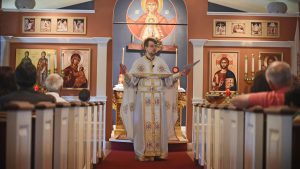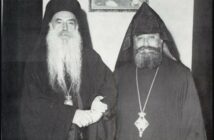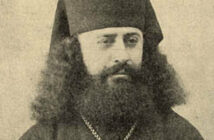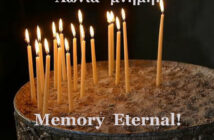
Kenneth K. Lam / Baltimore Sun
Father Gregory Gilbert, who grew up as a Southern Baptist, is now a Greek Orthodox priest.
Source: The Baltimore Sun
The Baltimore Sun
Growing up a Southern Baptist in eastern Tennessee, Brent Gilbert says, he never realized there were other ways to worship.
He figured everyone knew the best church music was contemporary.
He was sure there was a 45-minute pastor’s sermon at the heart of every Sunday service.
And didn’t all Christians agree that religious art, symbols and rituals were relics of a less desirable past?
Then he encountered the ancient faith that would change his life.
In the formal liturgy, rituals and language of the Greek Orthodox Church, he found a worship tradition so enriched by its direct link to lives of Christ’s original followers that it turns faith into an “all-encompassing phenomenon.”
Gilbert is neither ethnically nor culturally Greek — his forebears came to America from the British Isles. But after discernment and years of study, he’s now the Rev. Gregory Gilbert, the presiding priest of Sts. Mary Magdalene and Markella Greek Orthodox Church in Darlington — and a prominent example of the gradual but insistent wave of conversion that is turning a tradition long rooted in ethnic heritage into a more varied and, some say, more American movement.
Almost half the nearly 1 million Orthodox Christians in the United States today are converts, the Assembly of Canonical Orthodox Bishops of the United States of America reported in 2015. The majority of these married into the church. But a growing number are joining simply out of an affinity for the faith.
“We can still say that it’s not the majority of the laity — at this stage, most have been raised in the church — but there’s a lot of them,” says the Very Rev. Archpriest Andrew Damick, pastor of St. Paul Antiochian Orthodox Church in Emmaus, Pa., and the author of several books on Orthodox Christianity. “Conversion has already had a pretty big impact.”
Converts to Orthodoxy come from many backgrounds: former Evangelicals in search of historicity, analytical Christians seeking something more hands-on, weekend churchgoers in search of fuller, more regular engagement.
Gilbert says he has found a way of life that can be judged by its fruits.
“Americans have imbibed the idea that Christianity began about 500 years ago, at the time of the Reformation. But that view overlooks three-fourths of the history of the church,” the bearded 39-year-old says, and laughs. “Orthodoxy is a well-worn spiritual path more than an institution, and we know it has been producing saints for 2,000 years.”
At Sts. M. and M., as parishioners know the church, Gilbert stands out. More than 80 percent of the 100 families trace their religious roots to the three oldest Greek Orthodox parishes in Baltimore: the Greek Orthodox Cathedral of the Annunciation, St. Nicholas Greek Orthodox Church and St. Demetrios Greek Orthodox Church.
The Greek Orthodox Metropolis of New Jersey, the ecclesiastical territory of the national Greek Orthodox archdiocese that governs Maryland, established the parish in 2004 to serve the growing numbers of Greek Orthodox who had moved from Baltimore to Harford County.
For much of its first decade, Sts. M. and M. followed the pattern of the three older churches — and most Greek Orthodox churches in the United States — by engaging an ethnically and culturally Greek cleric, Fr. Manuel Burdusi, the former Proistamenos(spiritual leader) of St. Nicholas Church, to lead the congregation.
Deanna Karkoulas Mojarrad grew up attending St. Demetrios in Parkville. She and her husband were married there in 1993. They joined Sts. M. and M. in 2011.
Mojarrad says the parish loved the popular Burdusi during his tenure, at least in part because he was steeped in the Greek language and culture most have known since childhood.
When Metropolitan Evangelos of New Jersey, head of the Greek Orthodox Church in the mid-Atlantic, assigned the newly ordained Gilbert to be head priest of Sts. M. and M. in 2015, she feared he might have a hard time connecting.
He didn’t.
It helped that, as a former college classics major, Gilbert was fluent in Greek. But Mojarrad says it was his down-to-earth personality, his commitment to the faith, his deep knowledge of church and other history, and his empathy for parishioners of all ages that won the congregation over, and quickly.
“I believe this is exactly what Fr. Gregory was intended to do,” she says. “And I believe his success here is good overall from a big-picture perspective. It starts to solidify the idea that you don’t have to be a certain nationality to be a Greek Orthodox priest.”
Such has not always been the prevailing view within the 14 branches, or jurisdictions, of the Orthodox Church in the United States.
It has been more than a century since the first major wave of immigrants from the Orthodox nations of Greece, Russia, Ukraine and Romania began arriving on American shores in search of economic opportunity.
In their home countries, Orthodox Christianity was a de facto national religion.
When hundreds of thousands of immigrants from those nations arrived in the late 19th and early 20th centuries, many wanted to establish communities similar to the ones they came from. They created Orthodox parishes that married their religious and cultural traditions.
Churches such as the Greek Orthodox Cathedral of the Annunciation in Baltimore, founded in 1906, served the social and spiritual needs of those burgeoning communities, hosting everything from religious services in the language of the home country to dances and cultural festivals that kept old-world customs alive.
But as the decades passed, the realities of assimilating to life in a new country began challenging the ethnic and cultural homogeneity of many such parishes, whether they were rooted in Greek, Russian, Antiochian (Syrian) or other Orthodox traditions.
First- and second-generation immigrants generally held to the customs that bound them, but as younger parishioners began marrying in growing numbers outside the Orthodox faith, some left the fold, and outsiders sought to join.
The impact varies across the jurisdictions, but change is evident.
More than 70 percent of the roughly 75,000 Antiochian Orthodox Christians in the United States are converts. The Orthodox Church in America, with roots in Moscow and about 85,000 adherents, reports a 50 percent figure. In Greek Orthodox Christianity, by far the largest branch in the United States with almost 480,000 members, it’s about 25 percent.
Some say the Greek Orthodox Church has remained mostly Greek because the culture is so powerfully connected to the history and core principles of the faith.
Fr. Michael Pastrikos is head priest at St. Nicholas, one of the largest Greek Orthodox parishes in the area with more than a thousand families. He says there are reasons the jurisdiction is the largest of the Orthodox branches in the United States, including the fact that Christianity’s original liturgy and writings were in Greek.
“The Greek Orthodox faith is strong,” he says. “When people get into it, they don’t want to leave.”
Still, about 15 percent of his parishioners are converts.
“We’ve been around for 2,000 years. Over a time period like that, as a church, you have to evolve, and we’re evolving,” Pastrikos says.
The strength of Orthodox Christianity— also known as Eastern Christianity, Eastern Orthodoxy or Greek Orthodoxy — stems from the conviction that its traditions are the same as those practiced by Jesus’ original followers, the 12 apostles, and the theologians who codified those practices in their writings over the first few centuries after his death.
What emerged was a system of beliefs and behaviors the Orthodox have striven to keep intact.
A century before the Bible as we know it was composed, and centuries before the typical worshipper could afford one, elders were to read Christian Scriptures aloud during services every Sunday.
They were to share the consecrated bread and wine that the Orthodox (and some other Christians) believe becomes the literal body and blood of Christ. The faithful were to venerate the bones of martyrs, the holy images known as icons and other objects believed to inhere divinity, just as Jesus’ body did, and to fast regularly.
The church divided into Orthodox and Catholic in 1054 over the primacy and infallibility of the pope and other issues. What is known as the East-West schism in Christianity remains.
Gilbert knew none of that as a boy in eastern Tennessee. He was a devout Christian, a young man whose faith deepened during his teen years.
His views on religion changed as a result of his intellectual interests.
“I read my way into Orthodoxy,” he says.
At Davidson College in North Carolina, Gilbert majored in the classics and found himself fascinated with the writings of the early church fathers. They shared their views on Christianity in Koine Greek, their native tongue.
He began attending services at an Orthodox church near campus, and seeing practices he called “shocking:” believers venerating objects, chants that date to the first millennium, sermons that lasted a mere 15 minutes.
As he began tentatively practicing Orthodox rituals and learning church history, he felt his faith growing. He eventually came to believe in the church’s fundamental authenticity.
He attended St. Vladimir’s Orthodox Theological Seminary in New York, but mainly as an intellectual pursuit. He still planned to become a college professor.
His first day there, he surprised himself by kissing an icon in church.
“That was the moment I knew I’d crossed the Rubicon,” he says.
He converted. And after completing his seminary studies, traveling in Greece and earning a doctorate in Greek and Latin at the Catholic University of America, he was ordained a deacon and elevated to the priesthood in 2015.
Gilbert and his wife, Rachel, also a convert to Orthodoxy, live in Jarrettsville. They’re raising their five children to speak Greek and English, as he does in every service.
Some parishioners see his spiritual journey as a strength. Take Ezra Tillman, 29, who was raised in a conservative Baptist household.
Tillman has always been fascinated with history. He says a relative lack of historical context in his home church left him with a vaguely empty feeling.
He went with friends to a few Orthodox Church in America services. But he says the head priest, a native of Russia, seemed uncomfortable reaching out to newcomers.
At Sts. M. and M., Gilbert counseled him on the challenges he might face and baptized him into the faith.
Tillman says the congregation welcomed him warmly, and that he has become interested in the culture and language of most of his fellow parishioners.
“You can definitely feel the Greekness,” he says. “I like it, being in a place that is different. But I would call myself an Orthodox Christian who attends a Greek Orthodox church.”
Gilbert was doing what Damick, the Pennsylvania priest, says Orthodox parishes must do as they continue the journey of assimilation in the United States.
“We can’t just depend on immigration,” he says. “That’s one of those things outside the church’s control. We’re here on a mission, to bring Americans into our churches. Let’s bring our friends and neighbors in. We want them with us, no matter what their last names are.”
On a recent Sunday morning, Gilbert did for 50 people what Orthodox priests were doing for some 260 million around the world — leading a service that might have taken place in 400 A.D.
Worshippers entered, kissed icons, crossed themselves. Gilbert gave a short sermon on saints and moved on to a succession of chanted prayers.
Then he led a recitation of the Creed of the Council of Constantinople, a declaration of faith now 16 centuries old. “I believe in the one, holy, catholic and apostolic church,” the group intoned.
The small-c “catholic,” in this usage, means universality and openness to all — a fitting concept as Orthodoxy evolves.
“We have these ethnic titles in our names, but they refer to where our hierarchies reside,” Gilbert says. “None of these [jurisdictions]believes the church is for Greeks or Russians or Serbs. It’s a church for humans.”
twitter.com/jonpitts77



